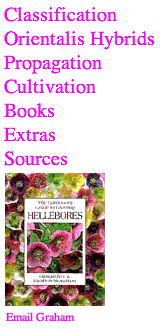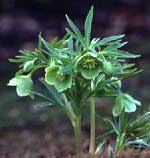
 |
Helleborus dumetorum Waldst. & Kit.
ne of the least cultivated of the hellebore species on account of its relatively small flowers, and the fact that it is less widespread than other green flowered species. But for hellebore enthusiasts this is a delightful plant and there may be scope for its use in breeding with a view to creating strains with large numbers of small but colourful flowers.
Description
A rather slender, truly herbaceous perennial, H. dumetorum reaches 8-12in (20-30cm) in height with leaves 10-12in (25-30cm) across. Each leaf has three undivided central leaflets with the outer two divided into three or more usually four segments making a total of 11-13. There are no hairs on the backs of the young leaves. The shape of the leaves and their segments are rather variable. On some plants, the leaves are reminiscent of a slimline H. atrorubens, others have long slender leaflets.The narrower leaflets are more inclined to be sparsely toothed than broader ones.
Flowering time is February and March and the flowers are the smallest of all hellebores, usually just over 1-11/2in (2.5-4cm) across or occasionally a little more and often rather starry in shape. There are usually three but sometimes up to nine flowers per stem and these are green in colour, nodding and unscented.
These small, green, unscented flowers distinguish this delicate species most clearly from other species. The leaves are more open than those of H. viridis and the leaflets are narrower and less toothed. This is also a slower growing plant than H. viridis with a more fibrous root system. The central leaves remain undivided and this distinguishes it from all forms of H. multifidus.
Natural Distribution and habitat
In the wild H. dumetorum is found in a broad east-west band stretching from H. atrorubens country in the Yugoslav provinces of Croatia and Slovenia, into southern Hungary and south-east Austria then possibly across Romania towards the Black Sea.
Generally this is a plant of scrub, light woodland or other shady places, especially clearings in beech woods with other plants such as Asarum europaeum, Anemone nemerosa, A. ranunculoides and A. trifolia, Cardamine bulbifera, Corydalis bulbosa, Crocus vernus, Epimedium alpinum, Euphorbia polychroma, Galanthus nivalis, Omphalodes linifolia, Pulmonaria officinalis, Symphytum tuberosum and Vinca minor.
Cultivation
This species is a definite shade lover and while other species which grow in shady places in the wild can tolerate more open positions in gardens, H. dumetorum seems more fixed in its ways. Given this more or less intractable preference, the usual humus rich but not waterlogged soil is suitable. Even given its ideal position with a good leafy soil it is noticeably slow growing compared with most species.
In gardens
Rarely grown in gardens except by enthusiasts and rarely offered by nurseries, this is another species which while not being grown for its flamboyant flowers or impressive foliage has an appealing elegance and grace. Like H. atrorubens it is best not grown with other plants whose bright colours or overpowering demeanour would distract us from its modest display. Choose from its wild companions or Anemone nemerosa 'Vestal' and 'Virescens', primroses, snowdrops and Pulmonaria angustifola subsp. azurea would also be good choices.
 |
|
|
|
|